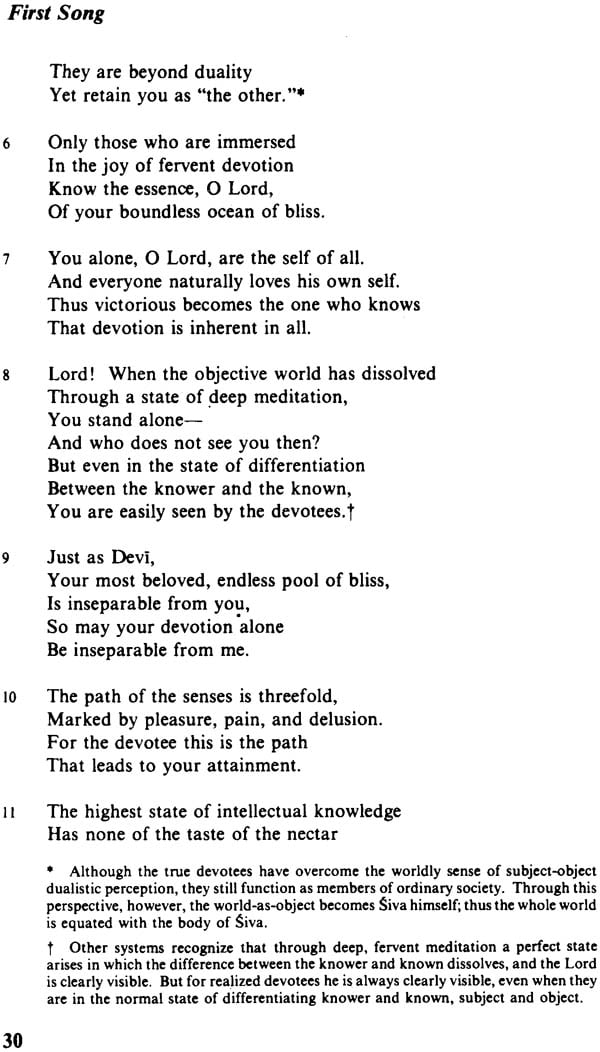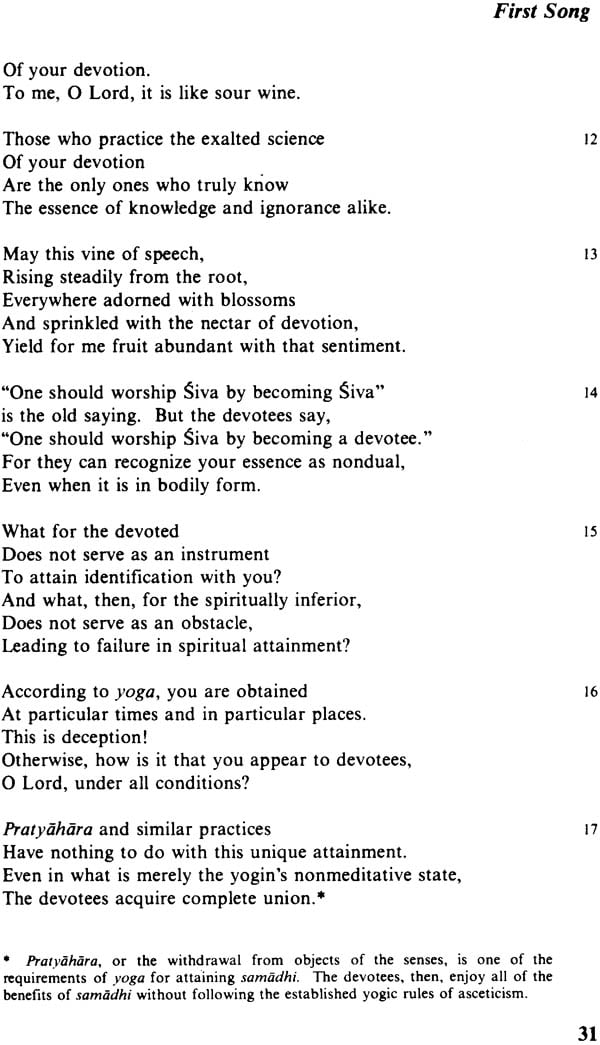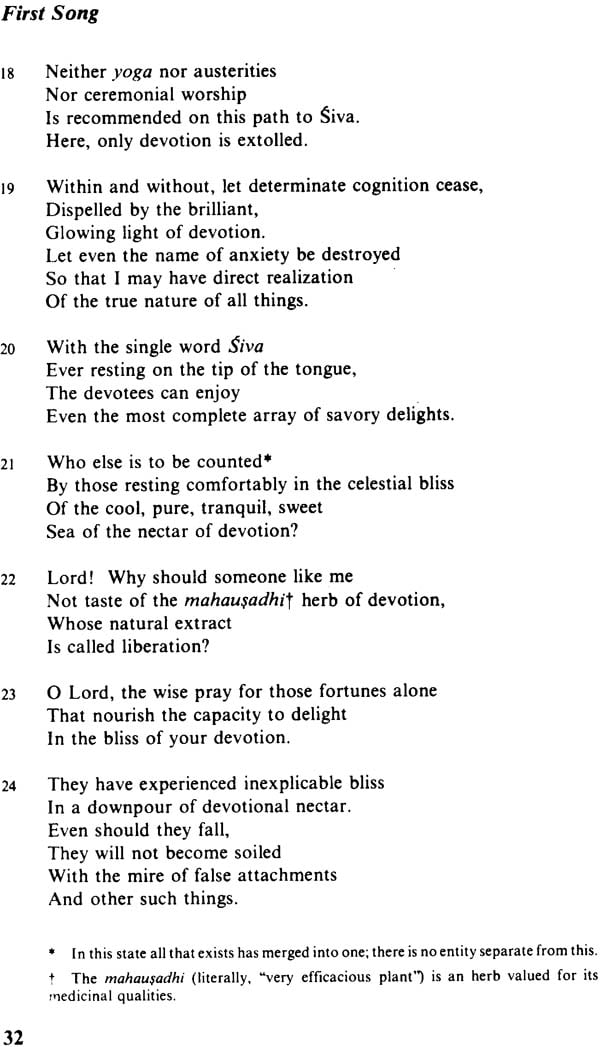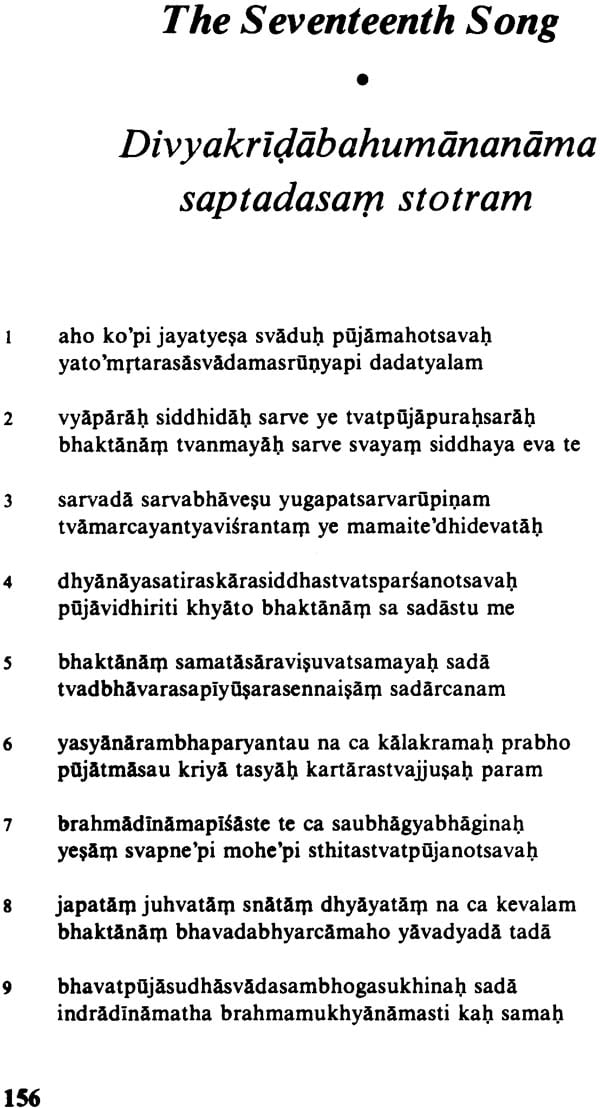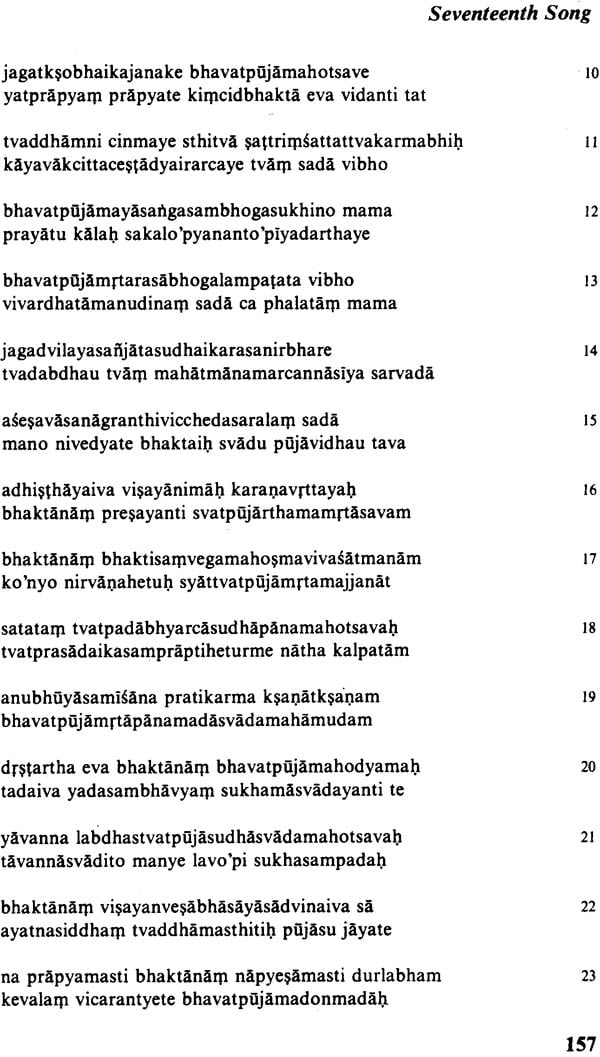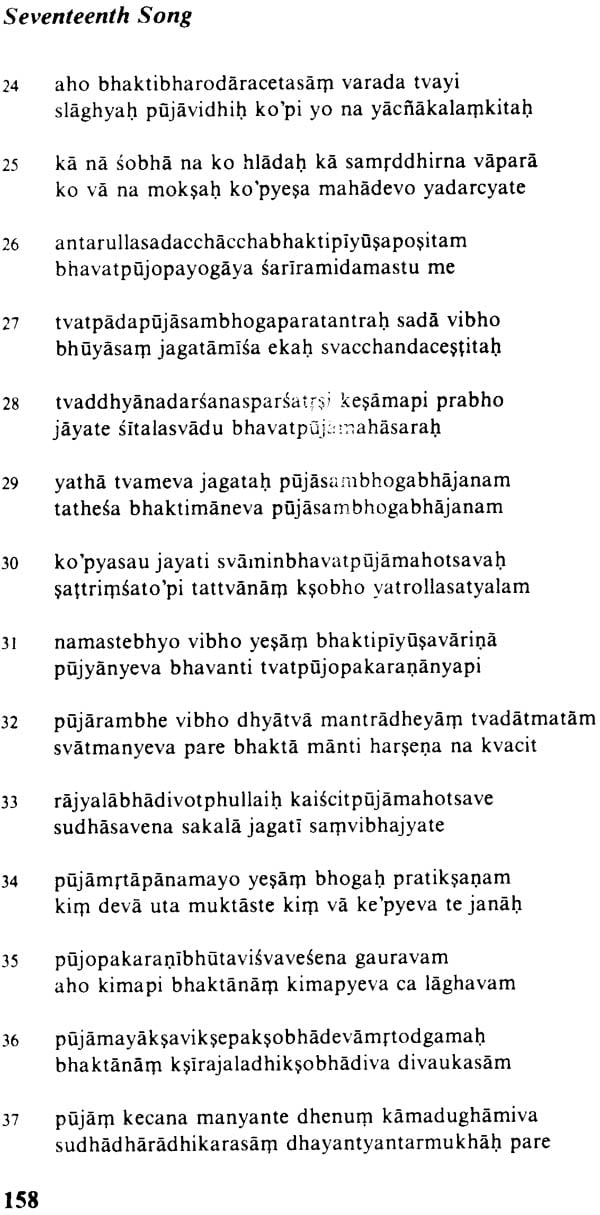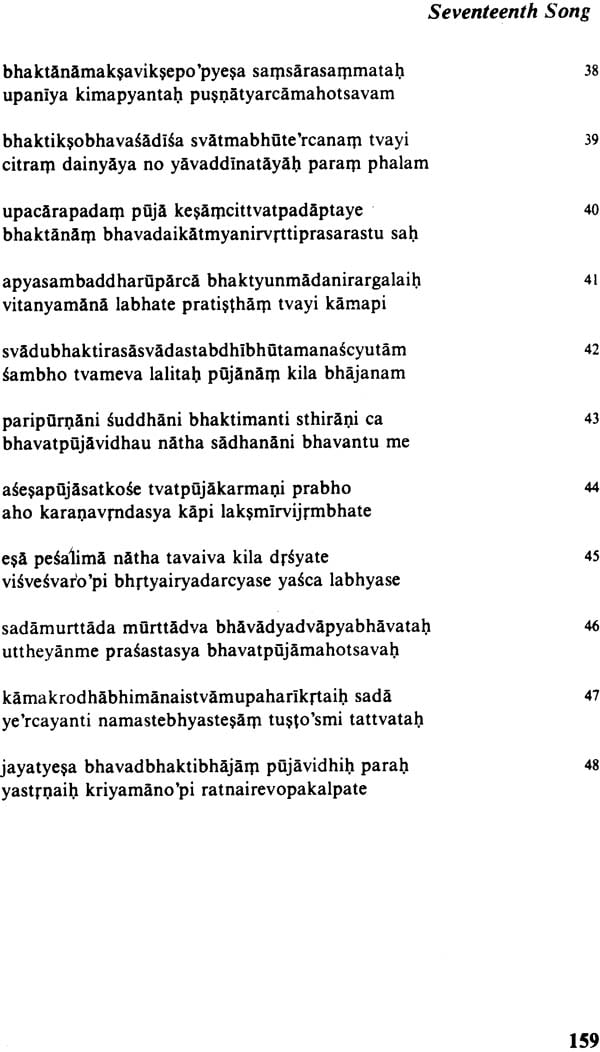
Shaiva Devotional Songs of Kashmir
Book Specification
| Item Code: | IHL252 |
| Author: | Constantina Rhodes Bailly |
| Publisher: | Sri Satguru Publications |
| Language: | (A Translation and Study of Utpaladeva’s Shivastotravali) |
| Edition: | 1990 |
| ISBN: | 8170302420 |
| Pages: | 206 |
| Cover: | Hardcover |
| Other Details | 8.9 Inch X 5.8 Inch |
| Weight | 330 gm |
Book Description
Utpaladeva was considered a siddha a perfected being one of the masters of the Tantric tradition in Kashmir and he is best known for his philosophical treatises. The shivastrotravali reflects Utpaladeva’s philosophy known as the Pratyabhijna School. And yet it is unique among the authors work in its not being a straightforward philosophical treatise but instead as Dr. Bailly points out in her introduction more of a spiritual diary of one who is actually treading the path of Shiva. The path that Utpaladeva has chosen does not require leaving one’s home and heading for mountain cave instead it calls of changing one’s view of the world for leading a life of divine recognition while carrying on with ordinary life.
In clearly written lucid prose Dr. Bailly illuminates the many faces of Utpaladeva’s quest. At the core of his spiritual journey is the enigmatic relationship between devotion and grace how much does spiritual attainment depend upon the individual’s efforts and how much is a divine gift? And how are these to be realized while living in the midst of society maintaining worldly obligations and lifestyle?
For over a thousand years the Shaiva community of Kashmir has used in its worship the hymns of Utpaladeva’s Shivastotravali. Here for the first time these hymns are presented in translation as English verse along with the Sanskrit a clear and lively introduction tow appendices on special aspects of Kashmir Shaivism, and additional notes.
Constantina Rhodes Bailly teaches in the philosophy and religion department of Mercy college new York.
Utpaladeva (ca. A.D. 900-950) well known as a founder of the Pratyabhijna school of philosophy in Kashmir is best remembered for his philosophical treatises most notably the Isvarapratyabhijnakarika which with its commentary Vimarsini of Abhinavgupta constitutes a major contribution to Indian philosophy in general. But Utpaladeva was foremost a highly realized devotee of Siva and is considered in Kashmiri tradition to have been a siddha. The recitation of the strotrasa or songs, of the Sivastotravali features in the worship of the Saiva community of Kashmir even to this day. Since the time of their composition they have been chanted in the same style and it has only been in the last fifty years that a more modern though still beautiful style has been adopted.
The Sivastotravali survives with the commentary of Ksemaraja who notes that these songs were not composed by Utpaladeva as a single structured work but rather were written sporadically during particular moods of devotional joy, anguish, praise, or the mere reflection of his own philosophical ideas. After Utpala’s death his discipline Srirama and Adityaraja are said to have been responsible for collection the songs which another disciple Visvavarta then divided into twenty chapters and provided with individual titles.
It is in the strotras of the Sivastotravali that the material of Utpaladeva’s treatises is experienced first hand by their author. This is not of course to say that a philosopher does not experience his material on some usually intellectual level. But it is in these songs that we are provided as though through a spiritual diary the ups and downs of one who not only speculates about the path toward realization but has tread it himself. Following him through the journey indeed from the very beginning we have the sense that we are accompanying Utpala on the wanderings on a marvelous pilgrimage.
The pilgrimage of course is through his own interior landscape testimony to the cosmic truth that he repeatedly strives to retain as a constant realization that his own body is united with the body of Siva that is the whole world. In his journeys we experine the wildness that both frightening and awe-inspiring that makes the poet wonder desperately whether his is just a voice crying out in the vast darkness. The geography of Utpaladeva’s interior pilgrimage nor surprisingly resembles the land of Kashmir with mountains and forests and quite prominently lakes with water lotuses. Along the dusty journey the wanderer seeks deep peace of mind likened to the cool depths of a mountain lake or to a hidden mountain recess.
We may regard the opening verse of the Sivastotravali as a benediction at the outset of the journey. A standardized obeisance to the deity or a supplication for protection might be expected before the actual subject of the piece begins. Observe however the object of homage in this fires verse :
Who meditates not nor recites by the rule
And yet without any effort at all
Attains the splendor of Siva
It is an though the opening is the very saktipata of the piece an initial shocking understanding is put to us that is to honor the devotee foremost for the true devotee has identified completely with Siva. This is a state that has come through the grace of Siva and through the devotion of the individual and therefore in the highest realization it is indeed a eulogy of Siva as well as the path itself the supreme path according to Utpaladeva of devotion.
By setting the focus as such from the opening verse Utpala reflects that already has he acquired insight into the reality of Siva consciousness but an inking of that vision is just beginning and the songs of the entire Sivastrovali are testimony to the joyful as well as painful realities of spiritual progression in an individual’s life. Similarly is the pilgrim compelled by his awakened spirituality to set forth and find more.
Background of the Sanskrit text
This book began as a doctoral dissertation that presented a translation of a selection of the songs and constituted an in-depth inquiry into the status of the manuscripts and the preservation of the textual tradition of the sivastotravalli. Between 1981 and 1983 I closely examined seven manuscripts two in Devanagari and the other five in Sarada the script traditionally used in Kashmir for writing in Sanskrit. I collected the manuscripts from as wide a geographical range as possible although understandably the greatest concentration of these manuscripts was to be found in Kashmir itself. After careful examination I concluded that there were no major variants in any of the manuscripts that I studied and that the textual tradition of the Sivastotravali remained intact without varying recessions.
The Sanskrit text of the Sivastotravali was first published in 1902 in the Chowkhamba Sanskrit series and was reissued in 1964 edited by the swami Laksman Joo of Srinagar. I did encounter some differences among the available texts the seven manuscripts plus the 1964 published edition which was based upon five or six unidentified manuscripts but these were for the most part simply errors in samdhi or the use of synonymous terms that fit into the meter exactly and that for the most part did not detract from the message of the verse for this book therefore I have followed the text as printed by the Chowkhamba Sanskrit series.
The Pilgrim Sets Forth
Selecting a path
The system put forth by Utpaladeva is essentially a religion of the householder. Thus can the spiritual quest be seen to be modeled on the activities of the pilgrim a householder who has taken a spiritual leave of absence from worldly functions rather than an ascetic who has severed with them altogether.
As a heuristic device to categorize the range of experience expressed in these songs it is useful to look at the broad categories representative of the Upayas of spiritual progress. There are three actual upayas plus a fourth transcendent one they can be thought of as a psychological ranking of an individual’s present spiritual inclinations and his potentials. Kashmir Saivis, is often praised for this psychological perceptiveness of the realities of just how each person can go about his spiritual progress an meet with neither too much challenge nor too much boredom.
The theory of the uprayas an inherent acknowledgements that the community of those following the path is comprised of a wide array of individuals one must not wait an unknown number of lifetimes to be born into a high caste or as a male in order to worship Siva or even dream of attaining his immediate realization rather the way is open not only to the high castes but also to low and even outcaste not only to men but to women and indeed to children not only to the renunciation but to the householder :
Who through your inspiration
while living the lives of average people
perceive just through these very eyes
Your from even before them.
Just the mere thought even a negative one is enough to set the process into motion.
Arises only hypocritically
Inevitably he acquires an appropriate
Closeness to you.
That the way is open to all creature is another way of acknowledgements conviction that with the body of Siva as the whole universe and all in it what or who indeed is not the same as the worshipper himself?
What then are the different upayas? The first anava upaya (the path of minuteness) is for those individuals most subject to anava or minuteness and whose consciousness has therefore become highly limited or bound. In this upaya much emphasis is placed on personal effort focused particularly on the realm of the senses. Thus ritual repetition of mantras and pranayama are prescribed.
The second sakta upaya (the way of power) or Jnana upaya (the way of knowledge) places a greater emphasis on mental awareness. The practitioner’s sense of duality begins to fade but he is still fixed with a dualist vision for this reason this way is also called bhedabheda upaya (the way of difference and nondifference).
The third upaya is sambhava upaya (the way of Sambhu or Siva) it entails a highly evolved consciousness whereby the will (iccha) predominates it is thus also called iccha upaya (the way of the will) in this upaya the practitioner can induce at will and retain for long periods a fixed awareness of the universe as pure consciousness.
The fourth and highest upaya like the fourth constituent of other Indian mystical progressions is not a upaya as such but represents the transcendence of the upayas themselves. Thus it is called anupaya or ananda upaya (the way of bliss). It requires almost no spiritual discipline for the practitioner where as we saw in the opening verse of the Sivastotravali the practitioner is beyond the need for meditation or the counting of prayer beads. Thus it is also known as pratyabhijna upaya (the way of recognition).
Using the categories of the upayas facilitates encompassing the broad range of experience of one on the path. More than anything the upayas are categories of psychological tendency each of which is expressed throughout the Sivastotravali. Unlike a philosophical as for example the yogasutra of Patanjali which delineates the stages of yoga from lowest to highest. The Sivastotravali rather takes the reader along the winding path of discover. In several places Utpala calls this path of devotion a creeper that is a vine that haltingly makes its way but that bears marvelous fruits.
| Acknowledgements | ix |
| Introduction | 1 |
| | |
| The First Song: The Pleasure of devotion | 29 |
| The Second Song: Contemplation of the All- Soul | 34 |
| The Third Song: The gift of affection | 39 |
| The Fourth Song: Potent Nectar | 43 |
| The Fifth Song: The Command of Powers | 48 |
| The Sixth Song: Tremblings along the Journey | 52 |
| The Seventh Song: Victory over Separation | 54 |
| The Eighth Song: Unearthly Strength | 56 |
| The Ninth Song: The Triumph of Freedom | 59 |
| The Tenth Song: Breaking the continuity | 62 |
| The Eleventh Song: Bound to the world by Desire | 66 |
| The Twelfth Song: Particulars of the Arcane Lore | 70 |
| The Thirteenth Song: In Summary… | 76 |
| The Fourteenth Song: Song the Glorification | 80 |
| The Fifteenth Song: About Devotion | 84 |
| The Sixteenth Song: Breaking out of the Fetters | 88 |
| The Seventeenth Song: A High Regard for Divine Amusements | 93 |
| The Eighteenth Song: Becoming Clear | 100 |
| The Nineteenth Song: The Meaning Revealed | 104 |
| The Twentieth Song: The Meaning Savored | 107 |
| Appendix A | 169 |
| Appendix B | 173 |
| Notes | 177 |
| Bibliography | 179 |
| Index | 195 |

